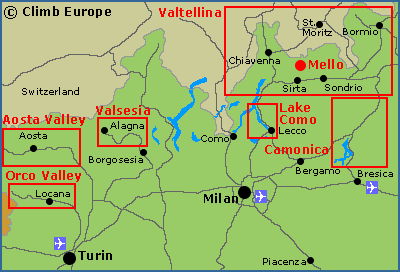Italian Alpine rock climbing
The Italian Alps offer a great range of climbing styles, in fantastic locations. There is everything from world class bouldering at Mello, to bolted sport routes, trad routes, and long alpine routes. The variety of rock type ranges from granite, gneiss, schist, and limestone, to marble and conglomerate. The popular areas are shown on the map and described below:
Rock climbing and bouldering at Val di Mello
Val di Mello is the best place to go bouldering in Italy with its own annual festival, Mello Blocco, which is held every spring. These granite boulders are situated in lush alpine meadows and shaded woodlands and provide a good range of problems across all grades. Find out more…
Val di Mello is surrounded by huge granite walls that feature endless cracks, corners and grooves. The granite rock is solid, featured and clean with the climbing ranging from single pitch sport routes to long multi-pitch mountain climbing up to 800m long, with everything in between and across all grades. Find out more…
Map of the best rock climbing areas in the Italian Alps

Rock Climbing in Valtellina and ValChiavenna
Valtellina and ValChiavenna are two of the largest valleys in the Italian Alps that host a huge variety of rock with different climbing opportunities and styles. Generally the climbing here is within the valley floor or at low altitude. The vast majority of the routes are bolted though some of the longer multi-pitch routes (300m+ long) do require some trad gear. Find out more…
ValChiavenna also offers excellent bouldering at places such as Cimaganda and Prestone. These bouldering areas are situated in alpine meadows, and are very accessible from the road. There is a good range of problems from easy to Font 8a on gneiss rock. The boulders along the riverbed are smooth and frictionless, whilst those in the meadows are course and have excellent friction.
To cover the wealth of climbing in the Val Masino, Valtellina and ValChiavenna areas, there are several different definitive guidebooks available. Mello boulder covers the bouldering, whilst the Val di Mello Rock Climbing Guidebook covers the trad and sport routes. The ValChiavenna and Engadine guidebook covers the sport routes and multi-pitch routes in the valleys at low altitude; whilst Solo Granite Volume 1 and Solo Granite Volume 2 cover the high altitude Alpine style routes. Valtellina Bloc covers all the bouldering in Valtellina and ValChiavenna except Mello. All of these guidebooks are available to buy from our shop.
The Orco valley (Valle dell'Orco) is located in the Gran Paradiso National Park, which is situated to the north of Turin and west of Milan. This valley is famous for its granite crack climbing, which is said to be the best in the Western European Alps, and is known locally as “Little Yosemite”. The climbing ranges from the sport climbing found in the lower valley to the multi-pitch Trad climbing on the epic big walls of Sergent, Caporal and the Torre di Aimonin, to the cliffs just below the Col de Nivolet. The definitive guidebook for this area is called the Valle dell'Orco guidebook that is available to buy from our shop.
The limestone crags that rise out of Lake Como near Lecco offer a great range of rock climbing. This area is huge with 100’s of crags and literally many 1,000’s of routes. There is everything from single pitch sport routes with simple approaches to long multi-pitch routes up to 500m long that demand a mountaineering approach. However there are many bolted multi-pitch sports routes between 100m to 300m long. Find out more about rock climbing in Lecco and Lake Como.
The Aosta Valley (Valle D'Aosta) has hundreds of single pitch and multi-pitch rock routes on well bolted gneiss rock. These routes are spread across a good range of grades with many delicate face climbs that range from 10m to over 350m long. The Aosta Valley is situated in the North West corner of the Italian Alps it is on the opposite side of the Mont Blanc tunnel from Chamonix. There is climbing throughout this valley from Courmayeur to Aosta and onto Point Saint Martin.
The best time to climb in the Aosta Valley is either side of mid-summer, as it is in the rain shadow of the French Alps around Chamonix. When it is wet and cold in Chamonix, a quick drive through the Mont Blanc tunnel can often find dry and warm rock in the Aosta Valley. The Plaisir Sud Band 2 guidebook is a selective guidebook describing both single pitch and multi-pitch sport routes in the Aosta Valley that is available to buy from our shop.
Rock Climbing at Valsesia
The Valsesia climbing area runs from the town of Borgosesia, along the valley passing Quarona and onto Alagna. Here there over 40 different crags and over 400 routes across a wide range of grades from F4a to F8b+. The style of climbing varies from super-technical or vertical walls to roofs and overhangs. The vast majority of the routes are bolted single pitch routes, though there are some multi-pitch routes over 200m long. Generally the climbing here is close to the valley floor with short approach times from the parking areas. The definitive guidebook for this area is called the Valsesia Rock Climbing Guidebook that is available to buy from our shop.
The Camonica Valley boasts a great variety of rock climbing with many different rock types to climb on. This ranges from limestone and Lombard verrucano (a compact type of red sandstone) to granite, schist and conglomerate. There are 1,000’s of routes in the Camonica Valley covering single pitch sport routes, multi-pitch routes and bouldering. Due to the various crags scattered along the length of the valley, at different altitudes, it is possible to climbing in the Camonica Valley throughout the year.
There is a comprehensive guidebook called the Camonica Valley rock climbing guidebook, covering 35 sport climbing areas, 3 bouldering areas and 2 long multi-pitch rock climbing areas.